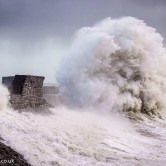
A first-of-its-kind storm wave study by Scottish researchers could provide vital storm damage protection to coastal areas.
The study, undertaken by researchers at the University of Edinburgh and in Japan, involved creating a model that looked at how water in strong waves collided with buildings, seawalls, rocks and cliffs. The model involved replicating stormy wave conditions in a 24-metre wave flume.
By understanding how the water collides and breaks down when impacting against structures, researchers believe this could form the basis for engineers to design future coastal defences that can effectively deal with stormy conditions.
Not only could this help protect buildings and natural structures but also it could prevent people being knocked over or injured by strong waves, or even being swept out to sea. With more storms becoming a feature each year, which may be the result of climate change, the findings from this study could prove extremely pertinent.
Interestingly, the researchers concluded that strong waves form a powerful jet of water that is thrown into the air when it comes into contact with an upright structure. This water splits into several sections, or fingers, before breaking down into droplets. This distinct pattern has enabled the researchers to develop a statistical model that can calculate spray produced by different sizes of waves. By knowing where and how water will hit different areas according to the size of waves, coastal defences can be built accordingly.
Although studies such as this could pave the way to building future coastal defences, it is always important to stay safe and be cautious when visiting the seaside during adverse weather conditions. Ensure you check the tide times before you go out so that you are not hit by strong, incoming tides, and keep away from stormy waves.
